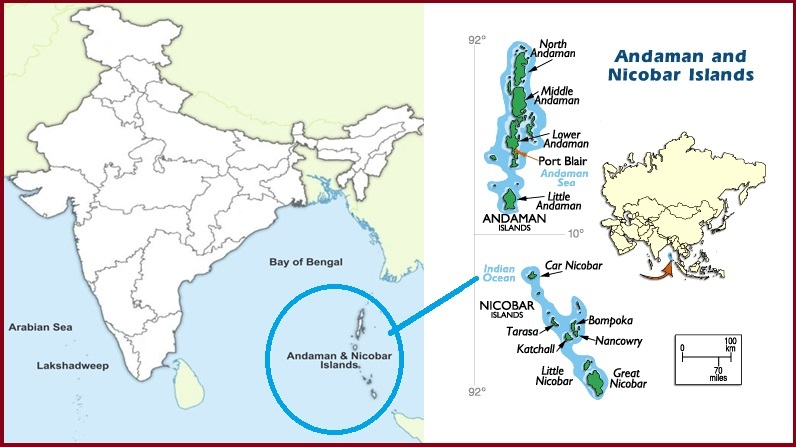Militarising Andaman and Nicobar Islands | 29 Jul 2020
This article is based on “Militarising Andamans: The costs and the benefits” which was published in The Hindustan Times on 29/07/2020. It talks about the challenges and opportunities associated with militarising Andaman and Nicobar islands.
The Galwan valley face-off with China has rendered many Indian security experts mooted the idea of balancing China in the maritime domain. In this context, strengthening military presence at the Andaman and Nicobar Islands (ANI) remains very critical for India.
The idea of militarizing the Andaman and Nicobar Islands is not new. Since the 1980s, Indian defense experts have advocated building strong strategic infrastructure at the ANI.
However, the strategic development of the ANI is not a straightforward choice for India’s defence and foreign policy establishments. Therefore, India must conduct a cost-benefit analysis before going for militarization of ANI.
Significance of Andaman and Nicobar Islands
- The Andaman and Nicobar Islands are located at the juncture of the Bay of Bengal and the Andaman Sea.
- It is a group of 572 islands, which straddles some of the busiest trade routes in the world.
- ANI spans 450 nautical miles in a roughly north-south configuration adjacent to the western entrance to the Malacca Strait, which is itself a major Indian Ocean chokepoint.
- Geopolitically, the ANI connects South Asia with South-East Asia. While the northernmost point of the archipelago is only 22 nautical miles from Myanmar, the southernmost point, Indira Point, is a mere 90 nautical miles from Indonesia.
- The islands dominate the Bay of Bengal, the Six Degree and the Ten Degree Channels that more than sixty thousand commercial vessels traverse each year.
- The Andaman and Nicobar Islands constitute just 0.2% of India’s landmass but provide near 30% of its Exclusive Economic Zone.
Opportunities in Militarising ANI
- Crucial for a Robust Indo-Pacific Strategy: As the geopolitical importance of the Indo-Pacific has been increasing, the Andaman and Nicobar Islands, located in the Bay of Bengal, have attained increased strategic significance.
- ANI could also become an important element of India’s “Act East Policy” of engaging with countries in the region east of India.
- Further, the Andaman and Nicobar chain of islands could be used as a basis for Indian maritime power projection into the Indo-Pacific and even beyond into the south-west Pacific.
- Strategic and Commercial Advantages: The ANI could be used for India’s Third Fleet and the trans-shipment hub at Car Nicobar, could potentially be a strategic game-changer, rivalling the ports of Singapore or Colombo.
- Strengthening Tri-Service Command: Changing nature of warfare in the 21st century has led to the expansion of scope of a Tri-Command Service. As Andaman and Nicobar is the only Tri-Command structure in India, development of military infrastructure at ANI is a key requirement in India’s security strategy.
Challenges in Militarising ANI
- May Portray the Image of Big Brother: When India first began developing the ANI in the mid-1980s, countries like Malaysia and Indonesia feared that India would use its military facilities in the ANI to dominate its region, and project power east of Malacca.
- Hence, it is not uncommon for India to be vilified as the ‘Big Brother’ by many of its neighbours in South Asia and South-East Asia.
- Therefore, a section of India’s diplomatic community has opposed militarising the ANI, arguing that turning ANI into a strategic-military garrison would militarise the littoral states and disrupt Indian ocean as a zone of peace.
- Ecological And Anthropogenic Aspect: Military infrastructure projects could devastate the fragile ecology of the ANI. Already many islands are facing significant damage from the climate crisis.
- Also, to establish a credible Aerial and Naval presence in an ethnographically extremely sensitive region presents complex challenges.
- Antagonising China: While China’s presence in the Indian Ocean is growing, it hasn’t so far militarised key Belt and Road Initiative (BRI) outposts in the Bay of Bengal (Hambantota, Chittagong and Kyaukpyu).
- If India pushes for greater military presence in the ANI, China could well seek military access in its friendly countries in Indian ocean .
Way Forward
- Bandwagoning with QUAD: In order to counter China’s expanding footprint in India’s sphere of maritime interest, India must permit friendly foreign navies (QUAD members, France etc.) access to the ANI’s military bases.
- The plan to integrate India’s undersea sensor chain with the existing US-Japan “Fish Hook” SOSUS network which seeks to monitor submarine activity in the South China Sea and the Indian Ocean Rim, is a step in the right direction.
- Balanced Development: Militarising ANI will aid India’s strategic capabilities, but such development should not come at the cost the ruthless exploitation of Biodiversity hotspot i.e ANI.
Conclusion
Militarising ANI is not a bad idea, but India must also take into account the downsides of such a move and the final decision should be based on a dispassionate weighing of costs and benefits.
|
Drishti Mains Question “The policy towards the Andaman and Nicobar islands should be transformed into something more robust strategic outlook, with an eye to India’s larger geopolitical interests”. Critically Discuss. |
This editorial is based on “Stress test” published in The Indian Express on July 28th, 2020. Now watch this on our Youtube channel.

